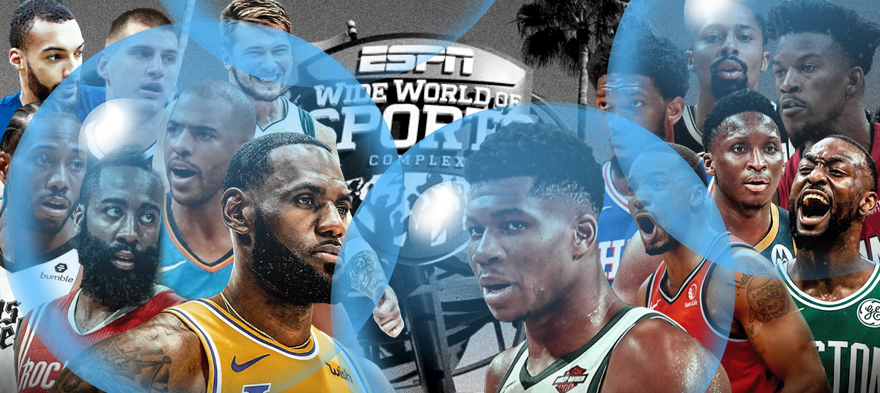
Oct 9, 2020 12:00:00 AM
Few physical institutions are stronger symbols of childhood than Walt Disney World’s theme parks. At its peak, nearly 250,000 children and their families visited the Walt Disney World parks and resorts each day. Say what you will about Disney World, but many children did indeed enjoy the “magic” of Disney, spinning in teacups, getting their favorite character’s autographs, and eating endless soft-serve ice cream while their parents ran up their credit card bills.
It will come as no surprise Disney World today looks quite different today than it did at the same time last year. Perhaps one of the biggest changes is that a sizable portion of the theme parks are now reserved for adults-only. More specifically, nearly 800 NBA players and staff have lived in Disney World for over three months, 24 hours a day in the “2020 NBA Bubble.” Yes, Mickey and Goofy stuffed animals have been swapped out for Gatorade and gym shoes.
After postponing the NBA season in March 2020, the league consulted with health experts and decided to create a sealed off village of over 800 players and staff in which the league controlled everything and no one from the outside was allowed in. At the price tag of around $1 million a day, the bubble includes a vast array of innovative and resource strategies to reduce the risk of COVID: daily testing, daily recorded temperature and oxygen saturation readings, wristbands that track your daily health symptoms and are used for entry into buildings, and proximity sensors that beep if a person is more than 6 feet from someone.
The bubble has its problems (isolation, separating families, mental health issues), but it has been remarkably successful in meeting its goals. The NBA has no reported COVID cases since the bubble quarantined. And as the NBA finals between the Miami Heat and the L.A. Lakers wraps up, it also means that in all likelihood, the 2019-2020 NBA season will indeed, finish.
So, [pullquote]while the NBA offers an optimistic story on what can happen when we combine science and tremendous resources within a system with tremendous pressure to re-open, the story of our school system paints a different picture.[/pullquote] Similar to the NBA, school was abruptly canceled in March 2020. Yet, nearly all U.S. schoolchildren did not get to finish their school year.
It’s not clear most students in the United States will even get to “play” for the 2020-2021 season. The childcare industry has been hit especially hard by the COVID-19 pandemic. It is estimated that two out of three programs are closed, causing educators to suffer even lower pay. This reality leaves many parents with the impossible task of being both full-time employees and caregivers.
Most concerning is the toll the lack of school takes on children. Breakthroughs across a diverse range of fields, including neurobiology, epigenetics, developmental science, and economics, point to the importance of developing skills early in life to maximize children’s potential. Decades of research demonstrate that children tend to have stronger academic, cognitive, language, and executive functioning skills when they attend high-quality early care and education programs. As young children are beginning to navigate their social world, active play with materials and social connections with their peers are critical for their regulatory and social skill development.
[pullquote]If we have the science and resources to get this right for NBA players, why can’t we do the same for our kids?[/pullquote]
The most obvious reason for such stark differences is resources. It is apparent that when our nation values something, we get it done. Clearly, we don’t value children in the same way we do professional athletes. This isn’t the first time the U.S. has shown this lack of value for our youngest citizens: We are the only industrialized nation to have no paid maternal leave and one of only a handful of nations to have no universal preschool. [pullquote position="right"]The COVID-19 pandemic has only exacerbated the problem of not valuing children and families in the United States.[/pullquote]
And, no, the answer is not to seal off families into hermetically contained bubbles of 800 children and families. Perhaps the nation could figure out a way to give schools and children just a fraction of the resources the NBA has to support re-opening. Free daily testing? A limitless supply of masks and hand sanitizer? The list goes on and on.
Think of what Tomorrowland might look like for our young students because right now, there is no Magic Kingdom for children.
Terri J. Sabol, Ph.D., is a Public Voices Fellow of The OpEd Project, is an assistant professor in human development and social policy and faculty fellow at the institute for policy research at Northwestern University.
Few issues in education spark more tension and debate than standardized testing. Are they a tool for equity or a burden on students? A necessary check on school systems or a flawed measure of...
Charter schools are public schools with a purpose. Operating independently from traditional school districts, they're tuition-free, open to all students, and publicly funded—but with more flexibility...
Despite the benefits of a diverse teaching force, prospective teachers of color fall out of our leaky preparation pipeline at every stage: preparation, hiring, induction, and retention. Here’s what...
Ed Post is the flagship website platform of brightbeam, a 501(c3) network of education activists and influencers demanding a better education and a brighter future for every child.
© 2020-2025 brightbeam. All rights reserved.
Leave a Comment